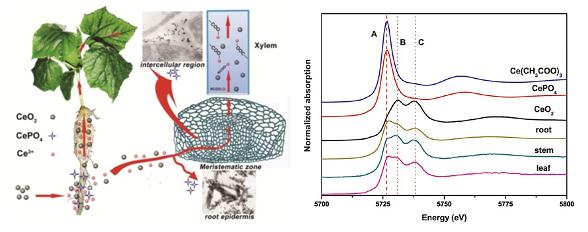| Biotransformation of CeriaNanoparticles in Cucumber Plants |
| From: PublishDate:2013-06-15 Hits: |
Ceria nanoparticles (NPs) aregenerally recognized as stable under environmental and biological conditions, and are unlikely to release heavy metal ions. Researchers from Multidisciplinary Research Center, Institute of High Energy Physics, the Chinese Academy of Sciences found that ceria NPs that attached to the surface of plant roots were reduced from Ce(IV) to Ce(III) by organic acids and reducing substancesexcreted by the roots. Their research has been published on an important journal in nanoscience, ACS Nano (Biotransformation of ceria nanoparticles in cucumber plants. ACS Nano, 2012, 6(11):9943-9950). Ceria NPs are one of the most important nanomaterials, they have various applications including dieselfuel-borne catalyst, cosmetic additives, and polishingagent, etc.They also have the promise to be appliedas superoxide dismutase and catalase mimetics due totheir electron transfer abilities. Moreover, due to the highly stable properties, ceria NPs are always used as an insoluble modelmaterial to study the behavior of nanoparticles inbiological or environmental systems. Researchers from Multidisciplinary Research Center, Institute of High Energy Physics found needlelike clusters on the epidermis and in theintercellular spaces of cucumber roots after a treatment with ceria NP suspensions for21 days.By using near edge X-ray absorption fine structureand soft X-ray scanning transmission microscopy technique based on BSRF and SSRF, they verified that the needlelike clusters were CePO4. The mechanism involved inthe biotransformation was addressed. This is the first report confirming the biotransformation of ceria NPs in biological systems. This implies that in the assessment of environmental safety and biomedical applications of ceria NPs, their biological and environmental transformation and the consequences of the transformation must be considered.
Using near edge X-ray absorption fine structure based on BSRF, it was confirmed that after a treatment with ceria NP suspensions for21 days, parts of Ce(IV) in roots, stems, and leaves of the cucumber plants were reduced to Ce(III).The proportions of Ce(III)were 34%, 13.6%, and 21.5%, respectively.
Article: Peng Zhang,#Yuhui Ma,#Zhiyong Zhang,* Xiao He, Jing Zhang,ZhiGuo,Renzhong Tai,Yuliang Zhao, and Zhifang Chai, Biotransformation of ceria nanoparticles in cucumber plants. ACS Nano, 6(11):9943-9950, 2012 |
|
|
| Chinese
Science Highlights
Home /
Copyright © 2011 - 2012 Beijing Synchrotron Radiation Facility


